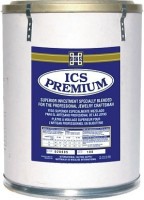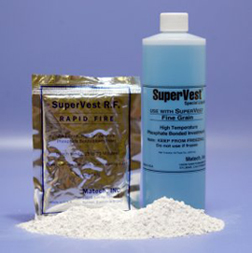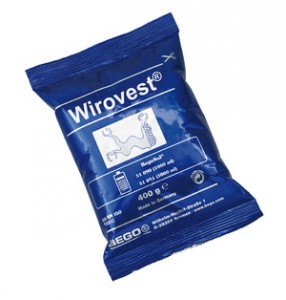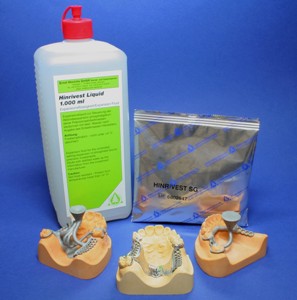An Investment Material can be described as a ceramic material which is suitable for forming a mold into which metal or alloy is cast. The procedure for forming the mold is described as investing.
Ideal Properties of investment material are –
1. Refractory substance: A material that will withstand high temperatures without decomposing.
2. A binder: A material which will set and bind together the particles of refractory substance.
In addition following properties are diserable :
3. The mold must expand to compensate for casting shrinkage on cooling the alloy.
4. The powder should have fine particle size to give a smooth surface on the casting.
5. Easily manipulated with enough working time.
6. It should have smooth consistency when mixed.
7. The set material should be porous enough to permit the air or other gases in the mold cavity to escape easily during casting procedure.
8. On being heated to higher temperature the investment must not decompose to give of gases that may corrode the surface of the alloy.
9. It should have enough strength at room temperature to permit ease in handling and enough strength at higher temp, to withstand impact force of the molten metal
10. Casting temp. should not be critical
11. Material should be economical
12. The investment should have enough expansion to compensate for casting shrinkage wax pattern and the metal that takes place during casting procedure.
13. Once the casting is completed, the investment should break away easily from the surface of metal and should not react chemically with it.
In general the investment material contains
1. Refractory material like silica, quartz, Cristoballite tridymite
2. Binders – Gypsum, Silica phosphate
3. Modifiers – like reducing agents, colouring materials
TYPES OF INVESTMENT MATERIAL:
There are 3 types of investment materials, They all contains silica as refractory material, the type of binder used is different.

Gypsum Bonded Investment:
These are used for casting gold alloys. They can withstand high temperature : Up to 7000 C
Phosphate bonded investment:
These are used for casting cobalt chromium alloys. They can withstand high temp.
Silica bonded investment: These are alternatives to phosphate bonded investment for high temp, casting. Principally used in casting of base metal alloy partial denture.
Gypsum Bonded Investment:
Classification: According to ADA Sp. No. 2, Casting investments for gold alloys – there are 3 types.
Type I : Are those used for casting of inlays or crowns and major compensation of casting shrinkage is accomplished by thermal expansion of the investment.
Type II: Are used for casting of inlay and crowns and major mode of compensation is by hygroscopic expansion of the inlays.
Type III: Are utilized for construction of partial denture with gold alloys.
COMPOSITION:
Refractory Material: They are forms of silica
They serve 2 functions
They provide refractory medium during heating
Regulate thermal expansion
Silica exists in atleast 4 altropic forms
Quartz, 2. Tridymite 3. Cristoballite 4. Fused quartz
Quartz or cristobalite or the combination of two is used .
Quartz or cristoballite
1. Act as refractory during heating
2. Regulate thermal expansion
3. Provide mold expansion
The dental stone shrinks when heated with addition of proper form of silica in the investment, such contraction is eliminated, changed to expansion during heating.
Quartz when heated inverts from a low form known as L-quartz to high form called as b-quartz at a temp of 5750C. Cristoballite when heated inverts from low L-cristoballite to high or b-cristoballite at a temp of 200 to 2700 C
The density decreases as l-form changes to b-form with a resulting increase in volume and rapid increase in linear expansion takes place.
Depending on type of silica used dental investments are classified as quartz or cristoballite investments.
BINDER:
Since the refractory material alone do not perform a coherent mass some kind of binder is needed the common binder used for dental casting gold alloy is dental stone L- Calcium phosphate hemihydrate
Gypsum:
1. It acts as a binder for silica in gold alloys casting with a melting range below 10000C
2. It imparts strength to the mold
Contributes to mold expansion by setting expansion when gypsum is heated to high temperature. It shrinks and fractures at 7000C it shows slight expansion and the great amount of contraction. The shrinkage is due to decomposition and release and sulphur dioxide
It contaminates the casting with sulfides of silver and copper, so the gypsum bonded investment should not be heated above 7000 C.
MODIFIERS:
1.Reducing agents
2.Modifying chemicals
3.Colouring matter
Setting Time:
ADA Sp. No- 2 for inlay casting investments. The setting time should not be less than 5 minutes and more than 25min. The modern inlay investments set initially in 9 to 18min.
1. Reducing agents: They reduce any oxides formed on the metal by providing a non oxidizing atmosphere in the mold when alloy enters the mold eg: carbon or copper powder.
2. Modifying chemicals: They regulate setting expansion and setting time and also prevent shrinkage of gypsum when heated above 3000C
Eg: Boric acid and sodium chloride
INVESTING:
The wax pattern should be cleaned of any debris, grease or oil. A commercial wax pattern cleaner or a diluted soap solution should be used. Any excess liquid is shaken off and pattern is left to dry when the investment is being prepared.
Manipulation by-
Hand mixing
Vacuum mixing
Double investing
Use of vibrator helps in reducing air bubble entrapment
Advantages of vacuum mixing:
Mechanical mixing under vacuum removes air bubbles created during mixing and evacuates harmful gases produced by chemical reaction of high investments. Amount of porosity in the casting is reduced by vacuum investing. As a result, the texture of the surface of the casting is some what smoother with a better detail reproduction compressive strength of vacuum investments is also increased.


